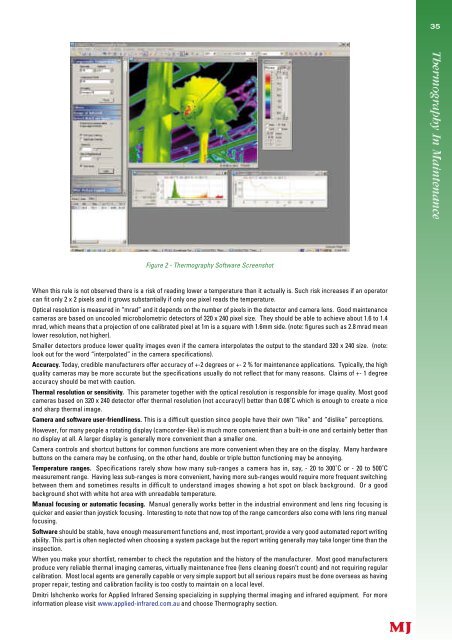August 2005 - Library
August 2005 - Library
August 2005 - Library
You also want an ePaper? Increase the reach of your titles
YUMPU automatically turns print PDFs into web optimized ePapers that Google loves.
Figure 2 - Thermography Software Screenshot<br />
When this rule is not observed there is a risk of reading lower a temperature than it actually is. Such risk increases if an operator<br />
can fit only 2 x 2 pixels and it grows substantially if only one pixel reads the temperature.<br />
Optical resolution is measured in “mrad” and it depends on the number of pixels in the detector and camera lens. Good maintenance<br />
cameras are based on uncooled microbolometric detectors of 320 x 240 pixel size. They should be able to achieve about 1.6 to 1.4<br />
mrad, which means that a projection of one calibrated pixel at 1m is a square with 1.6mm side. (note: figures such as 2.8 mrad mean<br />
lower resolution, not higher).<br />
Smaller detectors produce lower quality images even if the camera interpolates the output to the standard 320 x 240 size. (note:<br />
look out for the word “interpolated” in the camera specifications).<br />
Accuracy. Today, credible manufacturers offer accuracy of +-2 degrees or +- 2 % for maintenance applications. Typically, the high<br />
quality cameras may be more accurate but the specifications usually do not reflect that for many reasons. Claims of +- 1 degree<br />
accuracy should be met with caution.<br />
Thermal resolution or sensitivity. This parameter together with the optical resolution is responsible for image quality. Most good<br />
cameras based on 320 x 240 detector offer thermal resolution (not accuracy!) better than 0.08˚C which is enough to create a nice<br />
and sharp thermal image.<br />
Camera and software user-friendliness. This is a difficult question since people have their own “like” and “dislike” perceptions.<br />
However, for many people a rotating display (camcorder-like) is much more convenient than a built-in one and certainly better than<br />
no display at all. A larger display is generally more convenient than a smaller one.<br />
Camera controls and shortcut buttons for common functions are more convenient when they are on the display. Many hardware<br />
buttons on the camera may be confusing, on the other hand, double or triple button functioning may be annoying.<br />
Te m p e r a t u re ranges. Specifications rarely show how many sub-ranges a camera has in, say, - 20 to 300˚C or - 20 to 500˚C<br />
measurement range. Having less sub-ranges is more convenient, having more sub-ranges would require more frequent switching<br />
between them and sometimes results in difficult to understand images showing a hot spot on black background. Or a good<br />
background shot with white hot area with unreadable temperature.<br />
Manual focusing or automatic focusing. Manual generally works better in the industrial environment and lens ring focusing is<br />
quicker and easier than joystick focusing. Interesting to note that now top of the range camcorders also come with lens ring manual<br />
focusing.<br />
S o f t w a re should be stable, have enough measurement functions and, most important, provide a very good automated re p o rt writing<br />
ability. This part is often neglected when choosing a system package but the report writing generally may take longer time than the<br />
inspection.<br />
When you make your shortlist, remember to check the reputation and the history of the manufacturer. Most good manufacturers<br />
produce very reliable thermal imaging cameras, virtually maintenance free (lens cleaning doesn’t count) and not requiring regular<br />
calibration. Most local agents are generally capable or very simple support but all serious repairs must be done overseas as having<br />
proper repair, testing and calibration facility is too costly to maintain on a local level.<br />
Dmitri Ishchenko works for Applied Infrared Sensing specializing in supplying thermal imaging and infrared equipment. For more<br />
information please visit www.applied-infrared.com.au and choose Thermography section.<br />
35
















